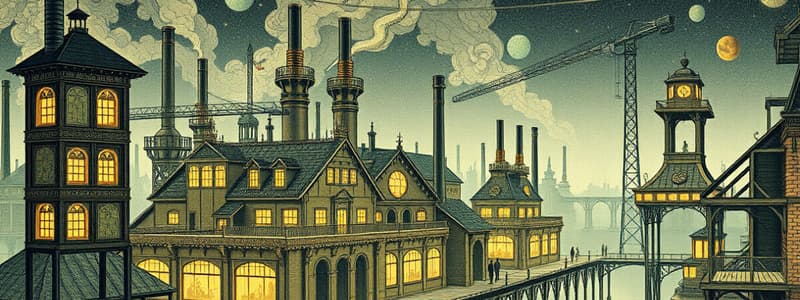Podcast
Questions and Answers
What characterized the first Industrial Revolution?
What characterized the first Industrial Revolution?
- It occurred from the early 20th century to 1850.
- It primarily took place in North America.
- It was mainly confined to Britain. (correct)
- It introduced the concept of the factory system.
Which statement best describes the second Industrial Revolution?
Which statement best describes the second Industrial Revolution?
- It took place in Britain, continental Europe, North America, and Japan. (correct)
- It lasted from the early 18th century to 1830.
- It primarily affected only British economies.
- It began in Japan and spread globally.
What economic transformation occurred during the Industrial Revolution?
What economic transformation occurred during the Industrial Revolution?
- Emergence of economies based on large-scale industry. (correct)
- Shift from industry to agriculture.
- Increased reliance on handicrafts.
- Decline of mechanized manufacturing.
How did the Industrial Revolution impact the middle class?
How did the Industrial Revolution impact the middle class?
What was one outcome of the industrial shift to the factory system?
What was one outcome of the industrial shift to the factory system?
Which invention was NOT significant during the Industrial Revolution?
Which invention was NOT significant during the Industrial Revolution?
What role did trade unions play during the Industrial Revolution?
What role did trade unions play during the Industrial Revolution?
Who is credited with perfecting the mass production of the automobile?
Who is credited with perfecting the mass production of the automobile?
Flashcards are hidden until you start studying
Study Notes
Timeline and Geography
- First Industrial Revolution occurred in Britain from the mid-18th century to around 1830.
- Second Industrial Revolution spanned from the mid-19th century to the early 20th century, impacting Britain, continental Europe, North America, and Japan.
- Spread of the second Industrial Revolution to other global regions in the late 20th century.
Economic Transformation
- Shift from agricultural and handicraft-based economies to large-scale industrial economies driven by mechanized manufacturing and the factory system.
- Introduction of innovative machines and power sources increased productivity and efficiency in existing industries.
- Emergence of new industries, notably the automobile industry in the late 19th century.
Societal Changes
- Overall wealth increased and was distributed more equitably, contributing to the growth of the middle class.
- Transition from domestic production to factory systems and mass production led to long working hours and often hazardous conditions for many, including women and children.
- Poor working conditions catalyzed the trade union movement in the mid-19th century.
Key Inventions
- Steam engine revolutionized transportation via locomotives, steamboats, and machinery in factories.
- Development of electric generators and motors, incandescent lamps, telegraphs, and telephones.
- Internal combustion engine innovations led to the mass production of automobiles, significantly advanced by Henry Ford in the early 20th century.
Notable Inventors
- James Watt enhanced the efficiency of the steam engine.
- Richard Trevithick and George Stephenson were pioneers in steam locomotive design.
- Robert Fulton created the first commercially viable paddle steamer.
- Michael Faraday demonstrated early electric generation and motor concepts.
- Joseph Wilson Swan and Thomas Edison independently invented the light bulb.
- Samuel Morse established the electric telegraph system and Morse Code.
- Alexander Graham Bell is renowned for inventing the telephone.
- Gottlieb Daimler and Karl Benz developed the first motorcycle and motorcar with high-speed internal combustion engines.
Studying That Suits You
Use AI to generate personalized quizzes and flashcards to suit your learning preferences.




